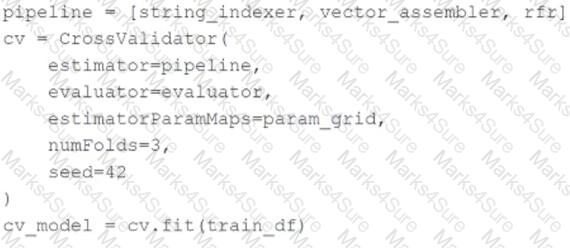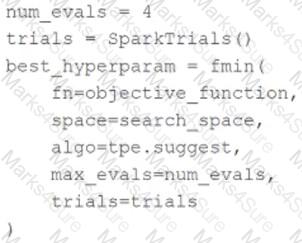A data scientist is using MLflow to track their machine learning experiment. As a part of each of their MLflow runs, they are performing hyperparameter tuning. The data scientist would like to have one parent run for the tuning process with a child run for each unique combination of hyperparameter values. All parent and child runs are being manually started with mlflow.start_run.
Which of the following approaches can the data scientist use to accomplish this MLflow run organization?
A data scientist wants to use Spark ML to one-hot encode the categorical features in their PySpark DataFramefeatures_df. A list of the names of the string columns is assigned to theinput_columnsvariable.
They have developed this code block to accomplish this task:

The code block is returning an error.
Which of the following adjustments does the data scientist need to make to accomplish this task?
A machine learning engineer has grown tired of needing to install the MLflow Python library on each of their clusters. They ask a senior machine learning engineer how their notebooks can load the MLflow library without installing it each time. The senior machine learning engineer suggests that they use Databricks Runtime for Machine Learning.
Which of the following approaches describes how the machine learning engineer can begin using Databricks Runtime for Machine Learning?
A data scientist has created two linear regression models. The first model uses price as a label variable and the second model uses log(price) as a label variable. When evaluating the RMSE of each model bycomparing the label predictions to the actual price values, the data scientist notices that the RMSE for the second model is much larger than the RMSE of the first model.
Which of the following possible explanations for this difference is invalid?
A data scientist has been given an incomplete notebook from the data engineering team. The notebook uses a Spark DataFrame spark_df on which the data scientist needs to perform further feature engineering. Unfortunately, the data scientist has not yet learned the PySpark DataFrame API.
Which of the following blocks of code can the data scientist run to be able to use the pandas API on Spark?
Which of the following describes the relationship between native Spark DataFrames and pandas API on Spark DataFrames?
Which of the following hyperparameter optimization methods automatically makes informed selections of hyperparameter values based on previous trials for each iterative model evaluation?
Which of the following approaches can be used to view the notebook that was run to create an MLflow run?
The implementation of linear regression in Spark ML first attempts to solve the linear regression problem using matrix decomposition, but this method does not scale well to large datasets with a large number of variables.
Which of the following approaches does Spark ML use to distribute the training of a linear regression model for large data?
A team is developing guidelines on when to use various evaluation metrics for classification problems. The team needs to provide input on when to use the F1 score over accuracy.

Which of the following suggestions should the team include in their guidelines?
A data scientist wants to parallelize the training of trees in a gradient boosted tree to speed up the training process. A colleague suggests that parallelizing a boosted tree algorithm can be difficult.
Which of the following describes why?
A data scientist has written a feature engineering notebook that utilizes the pandas library. As the size of the data processed by the notebook increases, the notebook's runtime is drastically increasing, but it is processing slowly as the size of the data included in the process increases.
Which of the following tools can the data scientist use to spend the least amount of time refactoring their notebook to scale with big data?
A machine learning engineer is trying to perform batch model inference. They want to get predictions using the linear regression model saved at the pathmodel_urifor the DataFramebatch_df.
batch_dfhas the following schema:
customer_id STRING
The machine learning engineer runs the following code block to perform inference onbatch_dfusing the linear regression model atmodel_uri:

In which situation will the machine learning engineer’s code block perform the desired inference?
A data scientist is developing a single-node machine learning model. They have a large number of model configurations to test as a part of their experiment. As a result, the model tuning process takes too long to complete. Which of the following approaches can be used to speed up the model tuning process?
A data scientist is wanting to explore the Spark DataFrame spark_df. The data scientist wants visual histograms displaying the distribution of numeric features to be included in the exploration.
Which of the following lines of code can the data scientist run to accomplish the task?
A data scientist has developed a random forest regressor rfr and included it as the final stage in a Spark MLPipeline pipeline. They then set up a cross-validation process with pipeline as the estimator in the following code block:

Which of the following is a negative consequence of includingpipelineas the estimator in the cross-validation process rather thanrfras the estimator?
A data scientist is using the following code block to tune hyperparameters for a machine learning model:

Which change can they make the above code block to improve the likelihood of a more accurate model?
A new data scientist has started working on an existing machine learning project. The project is a scheduled Job that retrains every day. The project currently exists in a Repo in Databricks. The data scientist has been tasked with improving the feature engineering of the pipeline’s preprocessing stage. The data scientist wants to make necessary updates to the code that can be easily adopted into the project without changing what is being run each day.
Which approach should the data scientist take to complete this task?